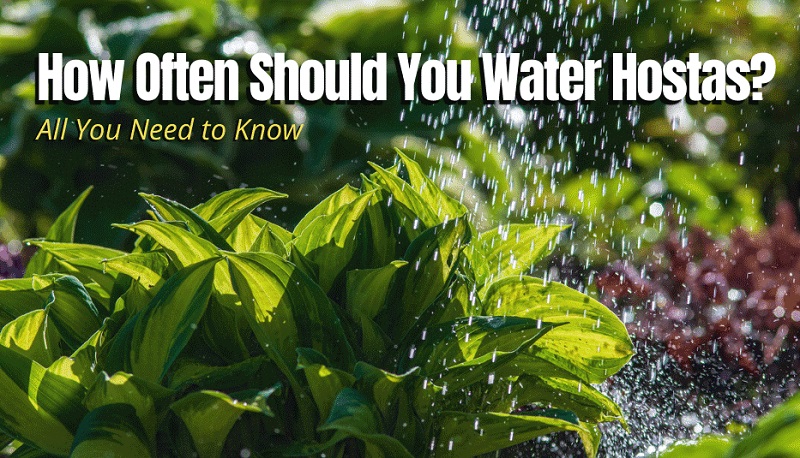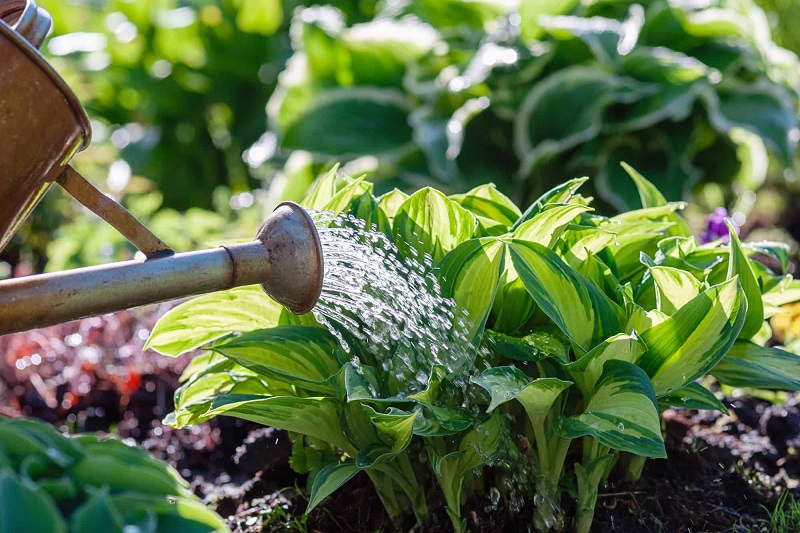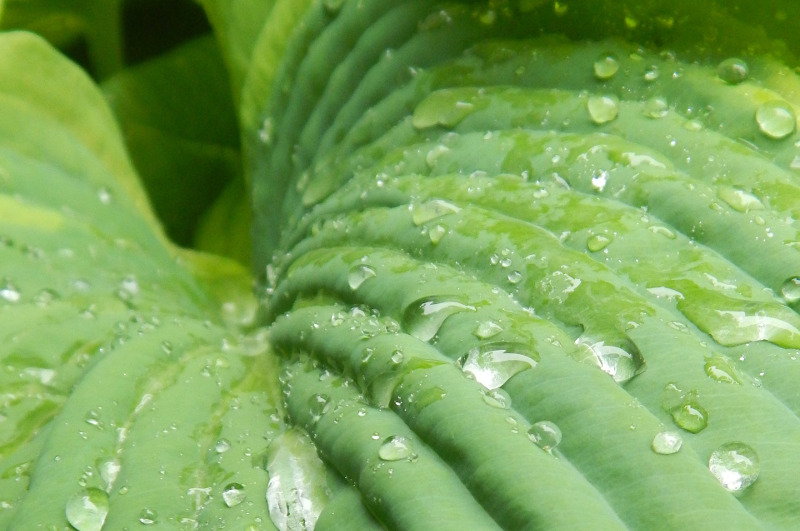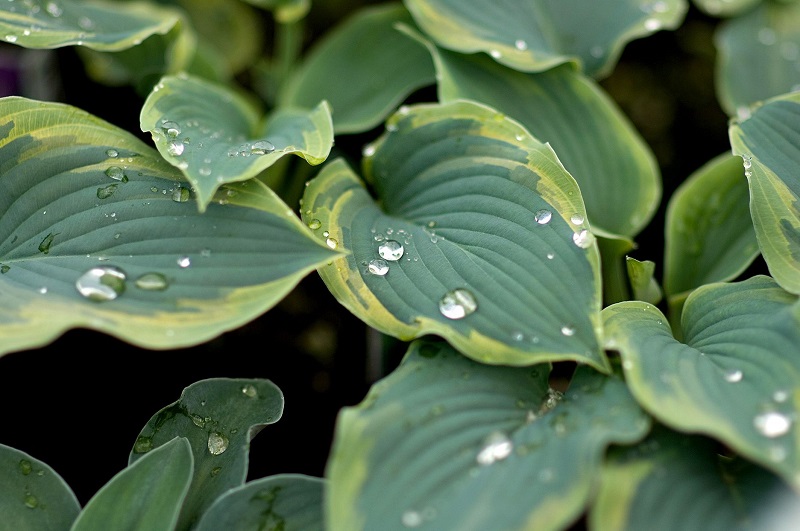Embarking on the journey of cultivating a thriving garden, one cannot overlook the pivotal role played by the meticulous care of each plant. Hostas, celebrated for their vibrant foliage and adaptability, demand attention to detail. Among the myriad facets of hosta care, the question that echoes in the minds of enthusiasts is: How Often Should You Water Hostas? Gina Farm will help you answer correctly through the following article.
How Often Should You Water Hostas?
Watering frequency for Hostas, like many plants, depends on various factors such as soil type, weather conditions and the maturity of the plant. Here are some general guidelines to help you determine how often to water your Hostas:
Soil Moisture:
Hostas prefer consistently moist but not waterlogged soil. Check the moisture level of the soil by sticking your finger into the soil up to the first knuckle. If it feels dry, it’s time to water.

Weather Conditions:
Hot and dry weather may require more frequent watering, while cool and rainy conditions may necessitate less. Adjust your watering schedule based on the weather to prevent overwatering or underwatering.
Established Plants:
Once Hostas are established (usually after the first growing season), they are generally more tolerant of different moisture levels. However, they still benefit from regular watering during dry spells.
Newly Planted Hostas:
Newly planted Hostas require more frequent watering to help them establish a strong root system. Water deeply after planting and continue to provide regular watering until they are established.

Mulching:
Applying a layer of mulch around your Hostas helps retain soil moisture, reduce evaporation and suppress weeds. Mulching can decrease the frequency of watering.
Time of Day:
Watering in the morning is often recommended because it allows the foliage to dry during the day, reducing the risk of diseases. Watering in the evening can lead to prolonged leaf wetness and increased susceptibility to diseases.
Container Hostas:
If you have Hostas in containers, they may need more frequent watering as containers tend to dry out faster than garden soil. Check the soil moisture regularly and water when the top inch of soil feels dry.
Rainfall:
Consider natural rainfall when deciding when to water. If your area has received significant rainfall, you may not need to water as frequently.

Overwatering can be as harmful as underwatering, so it’s crucial to find the right balance. Hostas are generally resilient and adjusting your watering routine based on the specific needs of your plants and environmental conditions will contribute to their health and vitality.
Best Time To Water Hostas
The best time to water Hostas is generally in the morning. Here are a few reasons why morning watering is recommended:
Reduced Risk of Fungal Diseases:
Watering in the morning allows the foliage of the Hostas to dry out during the day. This can help reduce the risk of fungal diseases, as many fungi thrive in moist conditions. Watering in the evening or at night may leave the foliage wet for an extended period, increasing the chances of fungal issues.

Optimal Absorption:
Watering in the morning provides the plants with moisture during the active part of their day. This allows them to absorb water and nutrients more efficiently, promoting healthy growth.
Minimized Evaporation:
Watering in the morning helps minimize water loss through evaporation. In the morning, temperatures are generally cooler and the sun is not as intense as later in the day. This means more water reaches the plant’s roots before evaporating.
Less Stress on Plants:
Watering in the morning helps prevent water stress during the hottest part of the day. If plants are watered when it’s excessively hot, water can evaporate quickly and the plants may experience stress.
Consistent Moisture:
Providing consistent moisture in the morning helps maintain a more stable soil moisture level throughout the day, benefiting the overall health of the Hostas.

While morning watering is generally recommended, it’s also important to consider the specific needs of your Hostas and the conditions in your garden. In extremely hot and dry weather, Hostas may benefit from an additional watering in the late afternoon or early evening. The key is to strike a balance and avoid overwatering, which can lead to issues such as root rot. Always check the soil moisture before watering to ensure that your Hostas receive the right amount of water based on their specific requirements.
How to Water Hostas?
Proper watering is crucial for the health and vitality of Hostas. Here are some tips on how to water Hostas effectively:
Watering Depth:
Provide a deep watering rather than frequent shallow watering. Watering deeply encourages the development of a deep and robust root system. Aim to moisten the soil to a depth of at least 6 to 8 inches.
Frequency:
Water Hostas when the soil is dry to the touch. Use the finger test by inserting your finger into the soil up to the second knuckle. If it feels dry at that depth, it’s time to water. However, avoid overwatering, as Hostas do not like to sit in waterlogged soil.

Morning Watering:
Water Hostas in the morning whenever possible. This allows the foliage to dry out during the day, reducing the risk of fungal diseases. Watering in the morning also ensures that the plants have access to moisture during their active growth period.
Water at the Base:
Direct the water at the base of the plant, avoiding wetting the foliage as much as possible. Watering at the base helps prevent fungal diseases and ensures that the water reaches the root zone where it’s needed most.
Soaker Hoses or Drip Irrigation:
Consider using soaker hoses or drip irrigation systems. These methods deliver water directly to the soil, minimizing water contact with the foliage. Soaker hoses can be placed around the base of the plants and drip irrigation provides a slow, steady supply of water to the root zone.
Mulching:
Apply a layer of organic mulch around the base of the Hostas. Mulch helps retain soil moisture, regulates soil temperature and reduces weed competition. It also contributes to overall soil health.

Avoid Overhead Sprinklers:
While Hostas appreciate consistent moisture, overhead sprinklers can wet the foliage excessively, increasing the risk of fungal diseases. If using sprinklers, do so early in the morning to allow the foliage to dry before evening.
Adjust for Container Hostas:
If you have Hostas in containers, check the soil moisture regularly, as container plants may dry out more quickly. Water when the top inch of soil feels dry and ensure that water drains freely from the bottom of the container.
The specific watering needs of Hostas can vary based on factors such as weather conditions, soil type and the age of the plants. Regular monitoring and adjusting your watering routine accordingly will help ensure the health and vitality of your Hostas.
Things to avoid when watering Hostas plants
When watering Hostas, there are certain practices to avoid to ensure the health and well-being of the plants. Here are some things to avoid:
- Overwatering: Hostas prefer consistently moist soil but are susceptible to root rot if the soil remains waterlogged. Avoid overwatering, especially if the soil has poor drainage. Check the soil moisture before watering and allow the top inch to dry out between waterings.
- Watering Too Shallow: Water deeply to encourage the development of a strong root system. Shallow watering may lead to shallow roots, making the plants more susceptible to stress during periods of drought.
- Watering in the Evening: Avoid watering Hostas in the evening or at night. Wet foliage during the night can promote the development of fungal diseases. Watering in the morning allows the foliage to dry out during the day.
- Overhead Sprinklers: While Hostas appreciate consistent moisture, overhead sprinklers can wet the foliage excessively. This increases the risk of fungal diseases. If using sprinklers, water early in the morning to allow the foliage to dry before evening.
- Ignoring Soil Drainage: Hostas prefer well-draining soil. Poor drainage can lead to waterlogged soil, which can be detrimental to the plants. Amend the soil with organic matter to improve drainage if necessary.
- Neglecting Mulch: Mulch is beneficial for Hostas as it helps retain soil moisture, regulates soil temperature and suppresses weeds. However, avoid piling mulch against the base of the plant, as this can create a moist environment that may attract pests and contribute to rot.
- Watering Overhead in Hot Weather: During hot weather, avoid watering Hostas overhead in the heat of the day. Watering when the sun is intense can lead to water droplets on the foliage acting as magnifying glasses, potentially causing leaf burn.

By paying attention to these factors and avoiding common mistakes, you can help ensure that your Hostas thrive and remain healthy throughout the growing season.
In Conclusion: Mastering the Art of Hosta Hydration
In the intricate tapestry of gardening, the meticulous care bestowed upon each element determines the overall success of your green haven. Hostas, with their resplendent foliage and adaptability, thrive when their hydration needs are met with precision. Crafting a watering routine that aligns with the unique characteristics of your Hostas is the key to unlocking their full potential.
Hopefully the above article from Gina Farm has helped you know How Often Should You Water Hostas? most effectively. From there, you can help your garden stay lush and green.